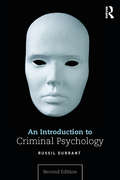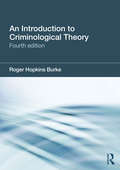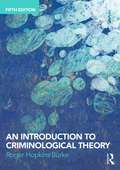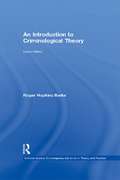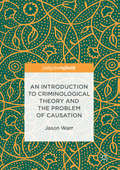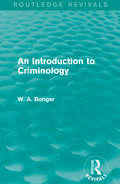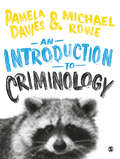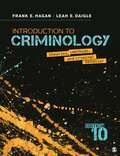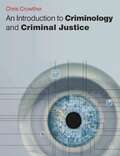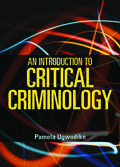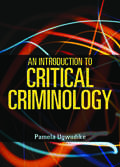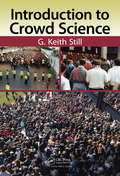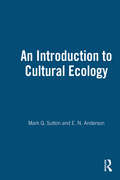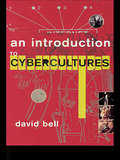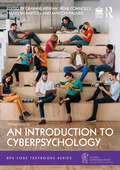- Table View
- List View
An Introduction to Criminal Psychology
by Russil DurrantThis book offers a clear, up-to-date, comprehensive, and theoretically informed introduction to criminal psychology, exploring how psychological explanations and approaches can be integrated with other perspectives drawn from evolutionary biology, neurobiology, sociology, and criminology. Drawing on examples from around the world, it considers different types of offences from violence and aggression to white-collar and transnational crime, and links approaches to explaining crime with efforts to prevent crime and to treat and rehabilitate offenders. This revised and expanded second edition offers a thorough update of the research literature and introduces several new features, including: detailed international case studies setting the scene for each chapter, promoting real-world understanding of the topics under consideration; a fuller range of crime types covered, with new chapters on property offending and white-collar, corporate, and environmental crime; detailed individual chapters exploring prevention and rehabilitation, previously covered in a single chapter in the first edition; an array of helpful features including learning objectives, review and reflect checkpoints, annotated lists of further reading, and two new features: ‘Research in Focus’ and ‘Criminal Psychology Through Film’. This textbook is essential reading for upper undergraduate students enrolled in courses on psychological criminology, criminal psychology, and the psychology of criminal behaviour. Designed with the reader in mind, student-friendly and innovative pedagogical features support the reader throughout.
An Introduction to Criminal Psychology: An Introduction To Criminal Psychology
by Russil DurrantThis book offers a clear, up-to-date, comprehensive, and theoretically informed introduction to criminal psychology, exploring how psychological explanations and approaches can be integrated with other perspectives drawn from evolutionary biology, neurobiology, sociology, and criminology. Drawing on examples from around the world, it considers different types of offences from violence and aggression to white-collar and transnational crime, and links approaches to explaining crime with efforts to prevent crime and to treat and rehabilitate offenders. This revised and expanded second edition offers a thorough update of the research literature and introduces several new features, including: detailed international case studies setting the scene for each chapter, promoting real-world understanding of the topics under consideration; a fuller range of crime types covered, with new chapters on property offending and white-collar, corporate, and environmental crime; detailed individual chapters exploring prevention and rehabilitation, previously covered in a single chapter in the first edition; an array of helpful features including learning objectives, review and reflect checkpoints, annotated lists of further reading, and two new features: ‘Research in Focus’ and ‘Criminal Psychology Through Film’. This textbook is essential reading for upper undergraduate students enrolled in courses on psychological criminology, criminal psychology, and the psychology of criminal behaviour. Designed with the reader in mind, student-friendly and innovative pedagogical features support the reader throughout.
Introduction to Criminalistics: The Foundation of Forensic Science
by William J. Tilstone Barry A.J. Fisher Catherine WoytowiczIntroduction to Criminalistics covers the basics of Criminalistics in a textbook for a one or two semester course, with the intention of preparing the student for a future in forensic science. The role of the Criminalist is to analyze, compare, identify, and interpret physical evidence in the crime lab. These crime labs, or forensic labs, have two primary functions: identifying evidence and linking the suspect, victim, and crime scene through physical evidence. This new primer introduces the learner to the structure and organization of the crime lab and to the role of the Criminalist. It features real cases – recent and historic – to illustrate concepts. Colorful pedagogy clearly defines chapter elements and sets this text apart from next best. Topics covered include how to process a crime scene and preserve evidence, the basic principles of firearm examination, latent fingerprints, and rudimentary toxicology, or how to determine the presence or absence of drugs and poisons. Well organized and methodical, this textbook has the potential to become the standard text for applying techniques of the physical and natural sciences to examining physical evidence. Uses real cases – recent and historic – to illustrate conceptsColorful pedagogy clearly defines chapter elements and sets this text apart from next bestPresents the basics of forensic sciences in a one-semester or one-year courseOffers excellent preparation for professional examinationsDelivers the latest in laboratory technique while acknowledging the limits of technology
An Introduction to Criminological Theory: An Introduction To
by Roger Hopkins BurkeThis book provides a comprehensive and up-to-date introduction to criminological theory for students taking courses in criminology at both undergraduate and postgraduate level. Building on previous editions, which broadened the debate on criminological theory, this book presents the latest research and theoretical developments. The text is divided into five parts, the first three of which address ideal type models of criminal behaviour: the rational actor, predestined actor and victimized actor models. Within these, the various criminological theories are located chronologically in the context of one of these different traditions, and the strengths and weaknesses of each theory and model are clearly identified. The fourth part of the book looks closely at more recent attempts to integrate theoretical elements from both within and across models of criminal behaviour, while the fifth part addresses a number of key recent concerns of criminology: postmodernism, cultural criminology, globalization and communitarianism. All major theoretical perspectives are considered, including: classical criminology, biological and psychological positivism, labelling theories, feminist criminology, critical criminology and left realism, social control theories, the risk society. The new edition also features comprehensive coverage of recent developments in criminology, including situation action theory, desistance theory, peacemaking criminology, Loïc Wacquant’s thesis of the penal society, critical race theory and Southern theory. This revised and expanded fourth edition of An Introduction to Criminological Theory includes chapter summaries, critical thinking questions, a full glossary of terms and theories and a timeline of criminological theory, making it essential reading for those studying criminology.
An Introduction to Criminological Theory
by Roger Hopkins BurkeThis book provides a comprehensive and up-to-date introduction to criminological theory for students taking courses in criminology at both undergraduate and postgraduate level. Building on previous editions, which broadened the debate on criminological theory, this book presents the latest research and theoretical developments. The text is divided into five parts, the first three of which address ideal type models of criminal behaviour: the rational actor, predestined actor and victimized actor models. Within these, the various criminological theories are located chronologically in the context of one of these different traditions, and the strengths and weaknesses of each theory and model are clearly identified. The fourth part of the book looks closely at more recent attempts to integrate theoretical elements from both within and across models of criminal behaviour, while the fifth part addresses a number of key recent concerns of criminology: postmodernism, cultural criminology, globalization and communitarianism. All major theoretical perspectives are considered, including: classical criminology, biological and psychological positivism, labelling theories, feminist criminology, critical criminology and left realism, social control theories, the risk society. The new edition also features comprehensive coverage of recent developments in criminology, including situation action theory, desistance theory, peacemaking criminology, Loïc Wacquant’s thesis of the penal society, critical race theory and Southern theory. This revised and expanded fourth edition of An Introduction to Criminological Theory includes chapter summaries, critical thinking questions, a full glossary of terms and theories and a timeline of criminological theory, making it essential reading for those studying criminology.
An Introduction to Criminological Theory
by Roger Hopkins BurkeThis book provides a comprehensive and up-to-date introduction to criminological theory for students taking courses in criminology at both undergraduate and postgraduate level. Building on previous editions, this book presents the latest research and theoretical developments. The text is divided into five parts, the first three of which address ideal type models of criminal behaviour: the rational actor, predestined actor and victimized actor models. Within these, the various criminological theories are located chronologically in the context of one of these different traditions, and the strengths and weaknesses of each theory and model are clearly identified. The fourth part of the book looks closely at more recent attempts to integrate theoretical elements from both within and across models of criminal behaviour, while the fifth part addresses a number of key recent concerns of criminology: postmodernism, cultural criminology, globalization and communitarianism, the penal society, southern criminology and critical criminology. All major theoretical perspectives are considered, including: classical criminology, biological and psychological positivism, labelling theories, feminist criminology, critical criminology and left realism, situation action, desistance theories, social control theories, the risk society, postmodern condition and terrorism. The new edition also features comprehensive coverage of recent developments in criminology, including ‘the myth of the crime drop’, the revitalization of critical criminology and political economy, shaming and crime, defiance theory, coerced mobility theory and new developments in social control and general strain theories. This revised and expanded fifth edition of An Introduction to Criminological Theory includes chapter summaries, critical thinking questions, policy implications, a full glossary of terms and theories and a timeline of criminological theory, making it essential reading for those studying criminology and taking courses on theoretical criminology, understanding crime, and crime and deviance
An Introduction to Criminological Theory (Criminal Justice: Contemporary Literature in Theory and Practice)
by Roger Hopkins BurkeFirst Published in 1997. Routledge is an imprint of Taylor & Francis, an informa company.
An Introduction to Criminological Theory
by Roger Hopkins BurkeThis book provides a comprehensive and up-to-date introduction to criminological theory for students taking courses in criminology at both undergraduate and postgraduate level. Building on previous editions, this book presents the latest research and theoretical developments. The text is divided into five parts, the first three of which address ideal type models of criminal behaviour: the rational actor, predestined actor and victimized actor models. Within these, the various criminological theories are located chronologically in the context of one of these different traditions, and the strengths and weaknesses of each theory and model are clearly identified. The fourth part of the book looks closely at more recent attempts to integrate theoretical elements from both within and across models of criminal behaviour, while the fifth part addresses a number of key recent concerns of criminology: postmodernism, cultural criminology, globalization and communitarianism, the penal society, southern criminology and critical criminology. All major theoretical perspectives are considered, including: classical criminology, biological and psychological positivism, labelling theories, feminist criminology, critical criminology and left realism, situation action, desistance theories, social control theories, the risk society, postmodern condition and terrorism. The new edition also features comprehensive coverage of recent developments in criminology, including ‘the myth of the crime drop’, the revitalization of critical criminology and political economy, shaming and crime, defiance theory, coerced mobility theory and new developments in social control and general strain theories. This revised and expanded fifth edition of An Introduction to Criminological Theory includes chapter summaries, critical thinking questions, policy implications, a full glossary of terms and theories and a timeline of criminological theory, making it essential reading for those studying criminology and taking courses on theoretical criminology, understanding crime, and crime and deviance
An Introduction to Criminological Theory (Criminal Justice: Contemporary Literature in Theory and Practice)
by Marilyn McShaneFirst Published in 1997. Routledge is an imprint of Taylor & Francis, an informa company.
An Introduction to Criminological Theory and the Problem of Causation
by Jason WarrThis text offers a novel contribution to the literature on core criminological theory by introducing the complex issues relating to the structuring and analysing of causation. This text traces the paradigm shift, or drift, that has occurred in the history of criminology and shows how the problem of causation has been a leading factor in these theoretical developments. This short book is the first of its kind and is an introductory text designed to introduce both seasoned criminologists as well as students of criminology to the interesting intersections between the fields of criminology and the philosophy of the social sciences.The problem of causation is notoriously difficult and has plagued philosophers and scientists for centuries. Warr highlights the importance of grappling with this problem and demonstrates how it can lead to unsuccessful theorising and can prevent students from fully appreciating the development of thinking in criminology. This accessible account will prove to be a must-read for scholars of criminal justice, penology and philosophy of social science.
An Introduction to Criminology (Routledge Revivals)
by W. A. BongerThis book, first published in 1936, provides an introduction to the various branches of criminology, including criminal psychology and criminology as an applied science. This title also provides an overview of some of the different criminological schools and theories. This book will be of interest to students of criminology and sociology.
An Introduction to Criminology (Routledge Revivals)
by W. A. BongerThis book, first published in 1936, provides an introduction to the various branches of criminology, including criminal psychology and criminology as an applied science. This title also provides an overview of some of the different criminological schools and theories. This book will be of interest to students of criminology and sociology.
An Introduction to Criminology
by Pamela Davies Michael RoweA comprehensive introduction to all the key topics, perspectives, and themes that you will cover when studying criminology and criminal justice. An Introduction to Criminology provides you with a thorough grounding in the main traditions and perspectives within the discipline and introduces cutting edge emerging themes that will shape criminology for years to come. It features insight from over 30 international experts with each chapter written by leading specialists within the field, giving you an in-depth and authoritative account of each vital area of study, from organised crime and victimisation to life-course criminology, prisons, and youth justice. Key features: Covers emerging areas of criminology and contemporary issues such as cybercrime, cultural criminology, hate crime, human trafficking, and gendered violence. Contains a range of features to help you study, including case studies and questions, student voices and advice, reflective exercises and more. Supports lecturers by providing access to a suite of online resources, featuring exclusive video content from the SAGE Video Criminology Collection, critical thinking exercises, multiple choice tests, and sample essay questions. Essential reading for any student of criminology, this will be a go-to reference text throughout your studies.
An Introduction to Criminology
by Pamela Davies Michael RoweA comprehensive introduction to all the key topics, perspectives, and themes that you will cover when studying criminology and criminal justice. An Introduction to Criminology provides you with a thorough grounding in the main traditions and perspectives within the discipline and introduces cutting edge emerging themes that will shape criminology for years to come. It features insight from over 30 international experts with each chapter written by leading specialists within the field, giving you an in-depth and authoritative account of each vital area of study, from organised crime and victimisation to life-course criminology, prisons, and youth justice. Key features: Covers emerging areas of criminology and contemporary issues such as cybercrime, cultural criminology, hate crime, human trafficking, and gendered violence. Contains a range of features to help you study, including case studies and questions, student voices and advice, reflective exercises and more. Supports lecturers by providing access to a suite of online resources, featuring exclusive video content from the SAGE Video Criminology Collection, critical thinking exercises, multiple choice tests, and sample essay questions. Essential reading for any student of criminology, this will be a go-to reference text throughout your studies.
Introduction To Criminology: Theories, Methods, And Criminal Behavior
by Frank E. Hagan Leah E. DaigleAn Introduction to Criminology
A comprehensive introduction to all the key topics, perspectives, and themes that you will cover when studying criminology and criminal justice. An Introduction to Criminology provides you with a thorough grounding in the main traditions and perspectives within the discipline and introduces cutting edge emerging themes that will shape criminology for years to come. It features insight from over 30 international experts with each chapter written by leading specialists within the field, giving you an in-depth and authoritative account of each vital area of study, from organised crime and victimisation to life-course criminology, prisons, and youth justice. Key features: Covers emerging areas of criminology and contemporary issues such as cybercrime, cultural criminology, hate crime, human trafficking, and gendered violence. Contains a range of features to help you study, including case studies and questions, student voices and advice, reflective exercises and more. Supports lecturers by providing access to a suite of online resources, featuring exclusive video content from the SAGE Video Criminology Collection, critical thinking exercises, multiple choice tests, and sample essay questions. Essential reading for any student of criminology, this will be a go-to reference text throughout your studies.
An Introduction to Criminology and Criminal Justice
by Chris Crowther-DoweyAssuming no prior knowledge, this text provides a clear and user-friendly introduction to the key definitions and issues of crime. With an unrivalled combination of scope plus introductory pitch, this is a one-stop shop for undergraduates taking their first modules in criminology and criminal justice.
An introduction to critical criminology
by Pamela UgwudikeCritical criminological theories and perspectives are typically major components of Criminology degree courses. An Introduction to Critical Criminology is the first accessible text on these topics for students of criminology, sociology and social policy. Written by an experienced lecturer who specialises in the topic, it offers an in-depth but accessible introduction to foundational and contemporary theories and perspectives in critical criminology. In doing so, it introduces students to theories and perspectives that challenge mainstream criminological theories about the causes of crime, and the operation of the criminal justice system. With the inclusion of boxed examples, key points and sample essay questions An Introduction to Critical Criminology is ideal for students of Criminology because it explores in detail a vast array of critical criminological theories and perspectives.
An introduction to critical criminology
by Pamela UgwudikeCritical criminological theories and perspectives are typically major components of Criminology degree courses. An Introduction to Critical Criminology is the first accessible text on these topics for students of criminology, sociology and social policy. Written by an experienced lecturer who specialises in the topic, it offers an in-depth but accessible introduction to foundational and contemporary theories and perspectives in critical criminology. In doing so, it introduces students to theories and perspectives that challenge mainstream criminological theories about the causes of crime, and the operation of the criminal justice system. With the inclusion of boxed examples, key points and sample essay questions An Introduction to Critical Criminology is ideal for students of Criminology because it explores in detail a vast array of critical criminological theories and perspectives.
Introduction to Crowd Science
by G Keith StillIncludes Case Studies from a Range of Event SitesIntroduction to Crowd Science examines the growing rate of crowd-related accidents and incidents around the world. Using tools, methods, and worked examples gleaned from over 20 years of experience, this text provides an understanding of crowd safety. It establishes how crowd accidents and incidents
An Introduction to Cultural Ecology
by Mark Q. Sutton E. N. AndersonThis contemporary introduction to the principles and research base of cultural ecology is the ideal textbook for advanced undergraduate and beginning graduate courses that deal with the intersection of humans and the environment in traditional societies. After introducing the basic principles of cultural anthropology, environmental studies, and human biological adaptations to the environment, the book provides a thorough discussion of the history of, and theoretical basis behind, cultural ecology. The bulk of the book outlines the broad economic strategies used by traditional cultures: hunting/gathering, horticulture, pastoralism, and agriculture. Fully explicated with cases, illustrations, and charts on topics as diverse as salmon ceremonies among Northwest Indians, contemporary Maya agriculture, and the sacred groves in southern China, this book gives a global view of these strategies. An important emphasis in this text is on the nature of contemporary ecological issues, how peoples worldwide adapt to them, and what the Western world can learn from their experiences. A perfect text for courses in anthropology, environmental studies, and sociology.
An Introduction to Cultural Ecology
by Mark Q. Sutton E. N. AndersonThis contemporary introduction to the principles and research base of cultural ecology is the ideal textbook for advanced undergraduate and beginning graduate courses that deal with the intersection of humans and the environment in traditional societies. After introducing the basic principles of cultural anthropology, environmental studies, and human biological adaptations to the environment, the book provides a thorough discussion of the history of, and theoretical basis behind, cultural ecology. The bulk of the book outlines the broad economic strategies used by traditional cultures: hunting/gathering, horticulture, pastoralism, and agriculture. Fully explicated with cases, illustrations, and charts on topics as diverse as salmon ceremonies among Northwest Indians, contemporary Maya agriculture, and the sacred groves in southern China, this book gives a global view of these strategies. An important emphasis in this text is on the nature of contemporary ecological issues, how peoples worldwide adapt to them, and what the Western world can learn from their experiences. A perfect text for courses in anthropology, environmental studies, and sociology.
An Introduction to Cybercultures
by David BellAn Introduction to Cybercultures provides an accessible guide to the major forms, practices and meanings of this rapidly-growing field. From the evolution of hardware and software to the emergence of cyberpunk film and fiction, David Bell introduces readers to the key aspects of cyberculture, including email, the internet, digital imaging technologies, computer games and digital special effects. Each chapter contains `hot links' to key articles in its companion volume, The Cybercultures Reader, suggestions for further reading, and details of relevant websites. Individual chapters examine: · Cybercultures: an introduction · Storying cyberspace · Cultural Studies in cyberspace · Community and cyberculture · Identities in cyberculture · Bodies in cyberculture · Cybersubcultures · Researching cybercultures
An Introduction to Cybercultures
by David BellAn Introduction to Cybercultures provides an accessible guide to the major forms, practices and meanings of this rapidly-growing field. From the evolution of hardware and software to the emergence of cyberpunk film and fiction, David Bell introduces readers to the key aspects of cyberculture, including email, the internet, digital imaging technologies, computer games and digital special effects. Each chapter contains `hot links' to key articles in its companion volume, The Cybercultures Reader, suggestions for further reading, and details of relevant websites. Individual chapters examine: · Cybercultures: an introduction · Storying cyberspace · Cultural Studies in cyberspace · Community and cyberculture · Identities in cyberculture · Bodies in cyberculture · Cybersubcultures · Researching cybercultures
An Introduction to Cyberpsychology (BPS Core Textbooks Series)
by Gráinne Kirwan, Irene Connolly, Hannah Barton, and Marion PalmerAn Introduction to Cyberpsychology provides a comprehensive introduction to this rapidly growing discipline. Fully updated in its second edition, the book encourages students to critically evaluate the psychology of online interactions and to develop appropriate research methodologies to complete their own work in this field.The book examines cyberpsychology and online research methodologies, social psychology in an online context, practical applications of cyberpsychology, and the psychological aspects of other technologies. This new edition has been carefully updated to include additional coverage of: Expanded content relating to major developments in the field and new content on gaming and screentime A new chapter examining the relationship between older adults and technology Cyberpsychology in focus feature boxes in each chapter that examine topics in depth Interviews with professionals working in fields relating to cyberpsychology Each chapter includes key terms and a glossary, content summaries, discussion questions, and recommended reading to guide further study.Supported by extensive online resources for students and instructors, this authoritative book is an essential core text for undergraduate modules in cyberpsychology, and an ideal primer for students of postgraduate programs in cyberpsychology.To view the additional student and instructor resources for this book, please visit bpscoretextbooks.routledge.com
